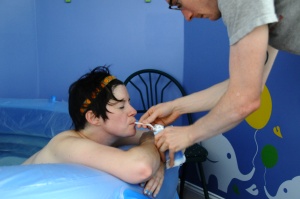Water Birth: Is It Safe and Does It Help?
16 July 2014 at 9:19 pm mfomcontributor Leave a comment
By Molly J Lawney, MPH
Being pregnant while pursuing a graduate degree in public health can have its downsides. For one, baby brain and academia in general do not go well together. Also, taking Intro to Environmental Health while pregnant is nothing short of terrifying. All I learned in that class is that there are horrible chemicals and compounds everywhere around you, so if you are planning on growing another human being, you should avoid the following: consuming fish, owning furniture, wearing clothing, and breathing the air. On the positive side, I was able to choose assignment topics that were also relevant to my personal life. For instance, when I took Perinatal Health Services and was asked to perform a literature review, I chose to write mine about water birth.
Like most people, I knew what water birth was, but had no idea whether it was safe or useful compared to birth on land. I assumed that because I hadn’t heard much about its safety or efficacy, there must not be a lot of recent research on the subject and I was initially concerned that there would not be enough studies to complete my assignment. The American College of Obstetricians and Gynecologists’ (ACOG’s) stance on water birth also suggested that there was not much research out there on water birth:
Immersion in water during the first stage of labor may be associated with decreased pain or use of anesthesia and decreased duration of labor. However, there is no evidence that immersion in water during the first stage of labor otherwise improves perinatal outcomes, and it should not prevent or inhibit other elements of care. The safety and efficacy of immersion in water during the second stage of labor have not been established, and immersion in water during the second stage of labor has not been associated with maternal or fetal benefit.
The ACOG says it right there: “the safety and efficacy… have not been established.” That must mean either no one has studied it properly, or the results were inconclusive. Bummer; there goes my assignment idea. I thought I would look through the library database anyway, just in case. Surprisingly, I found eight relevant studies from peer-reviewed journals, several of which were very large studies (see reference list below).
So then I thought, okay, if there are that many studies but the ACOG still says there is no evidence for its safety or efficacy…
Is water birth unsafe for babies?
The issue of the safety of water birth is largely centered on the risk of infection in the newborn from contact with microbes in the water. Although many of the studies found that the birth water does become contaminated during a water birth, there was no increased risk of infection for the newborn in any of the studies. Additionally, compared with land birth, there was no increased risk of neonatal intensive care unit (NICU) admissions in water-birthed babies. Furthermore, in a study that included over 2,000 water births, there was not a single case of water aspiration (breathing in the water) or drowning during birth.
All right, I thought, maybe the studies didn’t find increased risk of infection or NICU admissions because those are fairly rare events. Maybe the APGAR score, which stands for appearance (skin coloration), pulse (heart rate), grimace response, activity and muscle tone, and respiration (breathing rate and effort) is a better indicator of the health of water birthed babies. Each of the factors in the acronym is assigned a score of zero to two and then added to determine the overall APGAR score at one, five, and ten minutes after birth. Indeed, the one minute APGAR scores for babies born in water in these studies were lower than in land birthed babies. However, five minute APGARs were the same for water and land birthed babies across the studies and some of the studies even found a higher seven minute score in water birthed babies compared to land birthed babies.
What could this mean? Some of the researchers hypothesized that water birth is a gentler transition into the world for babies, so they don’t necessarily “know” that they have been born right away. This would result in a delay of the first breath and would thus lower the APGAR score. In other words, water birthed babies were just taking a little longer to get going, but it was not harming their health, as evidenced by their higher APGAR scores at ten minutes.
So water birth appears to be safe for babies….
What about the safety for moms?
Some of the studies I examined found that water birth resulted in higher post-birth hemoglobin levels in mothers who birthed in water compared with moms who birthed on land, which suggests that water-birthing mothers lost less blood during childbirth. There was less consensus across studies regarding perineal tearing, but overall, it appears that water birth results in higher rates of intact perineums and lower rates of serious tears that require suturing. Additionally, episiotomy rates are far lower in water birthing mothers than in land birthing mothers, likely because access to the area is less convenient for the provider.
If water birth is safe for both moms and babies, but the ACOG still isn’t on board…
Does water birth have any benefits?
Well, as the ACOG admitted, it does appear that water birth decreases the use of anesthesia during labor, as well as the duration of labor, especially during the second stage (the pushing phase). Water birth may also result in a lower need for labor augmentation with Pitocin—a drug often used to intensify contractions in women who do not seem to be progressing. Because of the lower need for pain and augmentation drugs, and the lower rates of tearing and episiotomy, water birth can be substantially less costly than birth on land.
At this point in my research, I was dumbfounded. The only possible question left was…
Is there something wrong with the studies?
The only possible reason left for the ACOG not to support water birth based on the current scientific evidence is that the studies related to water birth are fundamentally flawed in some way. One criticism of the aforementioned studies is that they are observational. The “gold standard” for scientific studies would be the randomized clinical trial; in all of these studies, the women opted for a water birth or not—they were not assigned to one of the options, randomly or otherwise. This is because it would be neither ethical, nor practical, to assign women to a water birth versus land birth. Thus, the type of women who decide to birth in water may be different from those who opt to birth on land in a way that could affect the outcomes of the studies. Perhaps they have a higher pain tolerance or they are in better overall physical health. Still, because it is unethical to assign women to a birthing condition, there is no way future studies could do so. Thus, obstetrical groups like the ACOG need to make a decision based on the evidence at hand. Furthermore, I needed to make a decision based on the evidence at hand for my assignment.
The Take-Home Message
Although the ACOG did not seem to think there was enough evidence to promote water birth, I disagreed. The studies that I found suggested that water birth is a safe and cost-effective labor and delivery technique. Water birth does not pose increased risk to newborns and it does provide effective, natural pain relief and protective health effects for the mother. Given the rapid rise in medical intervention in obstetrics over the last several decades, which has not necessarily been accompanied by improvements in maternal and neonatal outcomes, water birth deserves more attention as a possible solution to the problem of rising childbirth costs.
In case you are wondering what effect this assignment had on my personal decisions, I decided to have a birthing pool available to me. Although I did not ultimately give birth in the water, I did labor in the birthing pool for many hours. Not only did it relieve some of the pain from contractions, but it also relieved the horrible muscle spasms I had all throughout labor, which is one of the lovely side-effects of labor that no one tells you about ahead of time. I honestly do not think I would have succeeded at giving birth naturally without that birthing pool. In fact, my midwives even recorded in my chart that I said I wanted to marry the birthing pool!
Ultimately the decision to labor and/or give birth in water should be up to the laboring mother and her birth attendant. Unfortunately, because of the ACOG’s recommendations against water birth except in the setting of clinical trials, it means that birthing pools are not readily available to most women who opt to give birth in a hospital setting in the United States. If, however, enough women express an interest in water birth or laboring in water, it could change hospital policies and ultimately encourage the ACOG to reevaluate the recommendations.
References
- Maternal and neonatal infections and obstetrical outcome in water birth, published in the European Journal of Obstetrics & Gynaecology and Reproductive Biology;
- Water birth: is the water an additional reservoir for group B streptococcus? Published in the Archives of Gynecology and Obstetrics;
- The effects of immersion in water on labor, birth and newborn and comparison with epidural analgesia and conventional vaginal delivery, published in the Journal of the Turkish-German Gynecologic Assocation.;
- Waterbirths: A Comparative Study, published in Fetal Diagnostic Therapy;
- Maternal and perinatal outcomes amongst low risk women giving birth in water compared to six birth positions on land: A descriptive cross sectional study in a birth centre over 12 years, published in Midwifery;
- A retrospective comparison of water birth and conventional vaginal birth among women deemed to be low risk in a secondary level hospital in Australia, published in Women and Birth;
- Review of 1600 water births: Does water birth increase the risk of neonatal infection? Published in the Journal of Maternal and Fetal Neonatal Medicine;
- An economic evaluation of water birth: the cost-effectiveness of mother well-being, published in the Journal of Evaluation in Clinical Practice.
Entry filed under: Uncategorized.




Trackback this post | Subscribe to the comments via RSS Feed